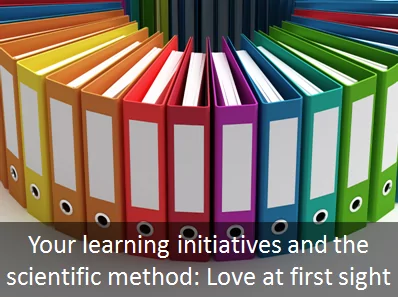The Scientific Method in Learning Initiatives, Part I

Based on the title of this article, you may well be wondering what in the world the scientific method has to do with your learning efforts. I boldly assert that the scientific method has everything to do with your learning initiatives. In fact, to the extent that you aren’t using the scientific method as part of your learning work, you’re missing out on the true power of learning to have profound impacts on business results. Did that catch your attention? I believe it is a true statement, and this article will explain why.
 What is the purpose of the scientific method? Quite simply: “The scientific method is a way to ask and answer scientific questions by making observations and doing experiments” (source). In case what you probably learned in high school has become a bit fuzzy, it consists of the following steps:
What is the purpose of the scientific method? Quite simply: “The scientific method is a way to ask and answer scientific questions by making observations and doing experiments” (source). In case what you probably learned in high school has become a bit fuzzy, it consists of the following steps:
- Ask the right questions.
- Conduct background research.
- Formulate a hypothesis.
- Test the hypothesis through an experiment.
- Analyze the results and draw a conclusion.
- Communicate the results.
Let me walk through this process and give you an example of how it might go in your company’s learning department.
Ask the right questions. A lot of times you don’t really get the luxury of asking the question yourself because it’s often handed to you, as in “We need a learning program that will help our salespeople boost their sales by 15%.” Either way, starting to ask questions is the first step in the process. If the order comes down from on high, there’s hopefully some actual business analysis that went into it. Clearly, sales are either declining, have plateaued, or aren’t growing as rapidly as the business wants them to. That’s the business problem being addressed. As a learning professional acting as a scientist, you’ve got to get to at least one root cause of this business problem if you’re going to design a learning program to address it. So the big question at this point in the process is this: Why are sales not where we want them to be?
Conduct background research. You’ve taken a look at the big-picture macroeconomics and can’t come up with any reasons there, so it’s not because of the state of the economy or anything like that, especially when competitors’ sales seem to be doing just fine. Then you get a brilliant idea. You decide to analyze the performance of your superstar salespeople to figure out what makes them successful. Google, by the way, proactively does this kind of research all the time to figure out what they want in new hires. When you conduct a thorough analysis of your go-to salespeople relative to underperformers, what you find out is startling and simple. The first thing you find out is that you have a lot more underperformers than superstars. If all your salespeople were performing like the superstars, company sales would be exactly where the upper brass wants them. And when you take a look at what distinguishes the stars from the others, it become pretty obvious that it appears to have everything to do with depth of knowledge about the product.
Formulate a hypothesis. Your hypothesis, then, in an unrefined form, is that increasing product knowledge in your salespeople will boost product sales. With the help of people who know how to really crunch data, you hone that further with specific numbers in this hypothesis: Raising the product knowledge of underperforming salespeople by 30% will boost company sales by 15%.
Notice however, that just in these first two steps, there’s a lot happening. You had to do a good deal of sleuthing to get to the root cause of the business problem you’re trying to address. Also, figuring out what makes your superstar salespeople so good is no small task either. In the end it turned out to be product knowledge, but this assumes that you came up with a way to meaningfully measure that, so you can see how complicated this can become. I’ll continue walking you through the importance of the scientific method in designing learning programs in the second part of this series.